Between the end of the fourteenth century and the first decades of the century to come, Florentine painting was filled with graceful, mostly angelic, musician figures. From Agnolo Gaddi to Gherardo Starnina, from Lorenzo Monaco to Fra’ Angelico, to name but a few of the major craftsmen, there is often a swarming, in altarpieces with religious subjects as well as in some less frequent works with profane themes, of animated creatures whose instruments enrich the compositions; they are often accompanied by singing angels, so that the silence of perception, whether mystical or aesthetic, is completed by a further level, virtually perceptible to the senses but silent, that of music and choral singing. Obviously for the viewer of the time, unlike the museum and exhibition-goer of today, such sensory perception was real, because in the arrangement provided for the polyptychs and altarpieces on the altars of church buildings, chapels and oratories, the singing and music depicted in the paintings were also “expressed” in those included in the liturgy. In the images intended for personal devotion, in the homes as well as in the cells of monks and friars, the devotee could participate in absence, if only through the filter of memory, in the properly cultic occasions. In the first as in the second case, moreover, the manifestations of sound referred to a higher form of perceptual contemplation, to celestial music, of the spheres.
Giovanni di Marco, called dal Ponte (Florence, 1385 - c. 1437/1438), participated with vivid invention in the wealth of musical representations of his time. The originality of this exponent of painting at the end of the Gothic period was well highlighted by the monographic exhibition Giovanni dal Ponte, protagonist of Florentine Late Gothic Humanism organized four years ago at the Galleria dell’Accademia in Florence, which made him known to a wider audience than specialists, to whom the painter has been well known since the beginning of the twentieth century. Nearly a dozen of his paintings involve the depiction of musical instruments, and the first, in order of time, is the Madonna and Child between Saints John the Baptist and Catherine of Alexandria in the Wadsworth Atheneum Museum of Art in Hartford (c. 1415-1420), executed for private devotion. Here eight slender, darting angel figurines, emerging from blankets of clouds, flow along the splay of the frame: the two pairs at the top, alongside the descent of the Holy Spirit, are praying, while those further below are playing instruments normally seen in other fourteenth- and fifteenth-century religious images, namely a psaltery, a portative organ, a tambourine, and an instrument similar to a small lute, which Arianna Soldani, in a specific essay devoted to Giovanni dal Ponte, tends to recognize as a chitarrino (quite different from the type of modern guitar), which also differs from the lute in that it has strings that extend the full length of the sound box. The inclusion of these angels in the space of the frame, on a separate and raised level from that of the main figuration, is not without comparisons in Florentine painting of the period and anticipates a tabernacle by Angelico (Florence, Museo di San Marco), linked to Dominican devotion: in both exemplars music is reserved for the lower level of the angelic procession, while as one rises spiritually it gives way to prayer and pure contemplation of the divine, in a transcendent perspective.
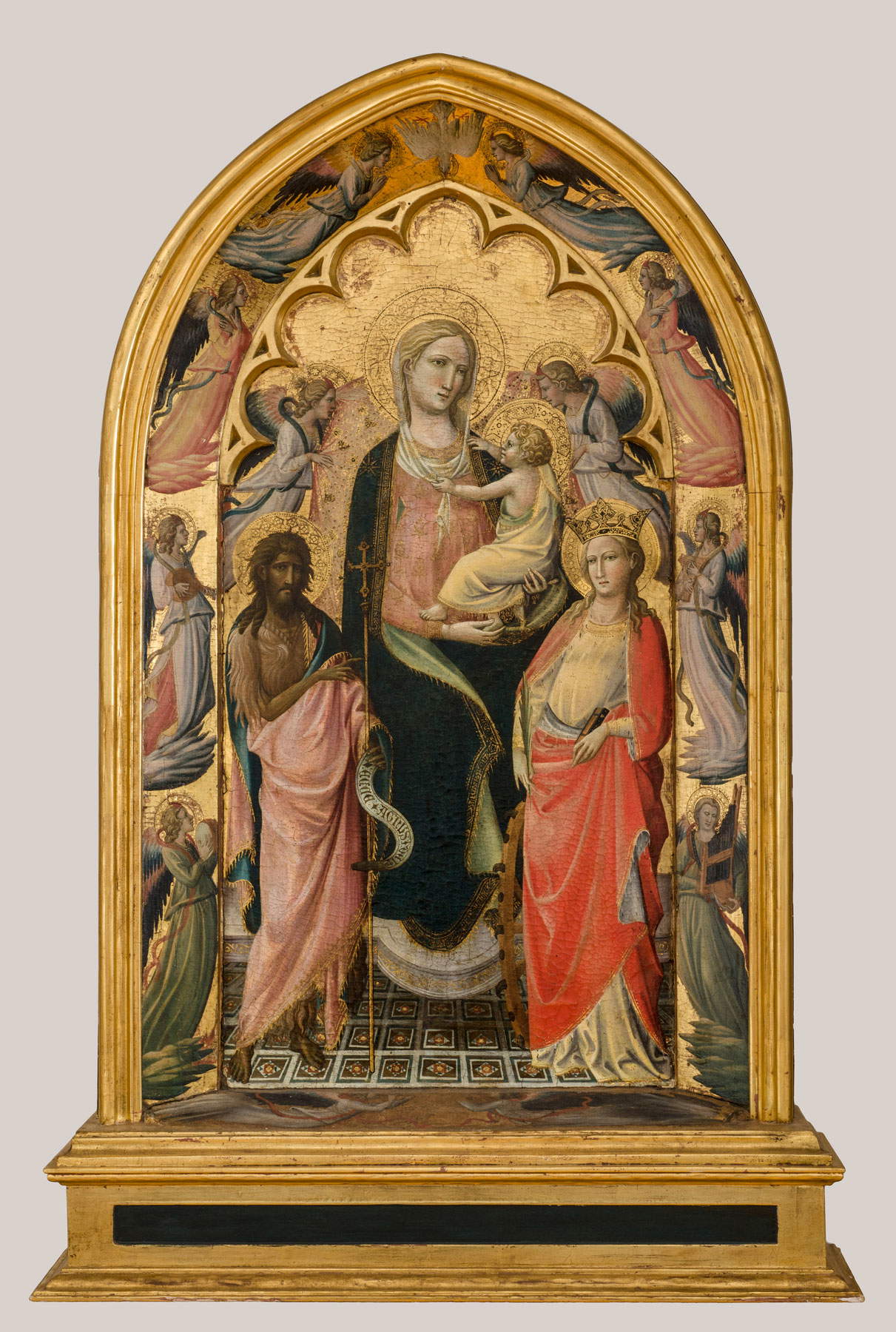
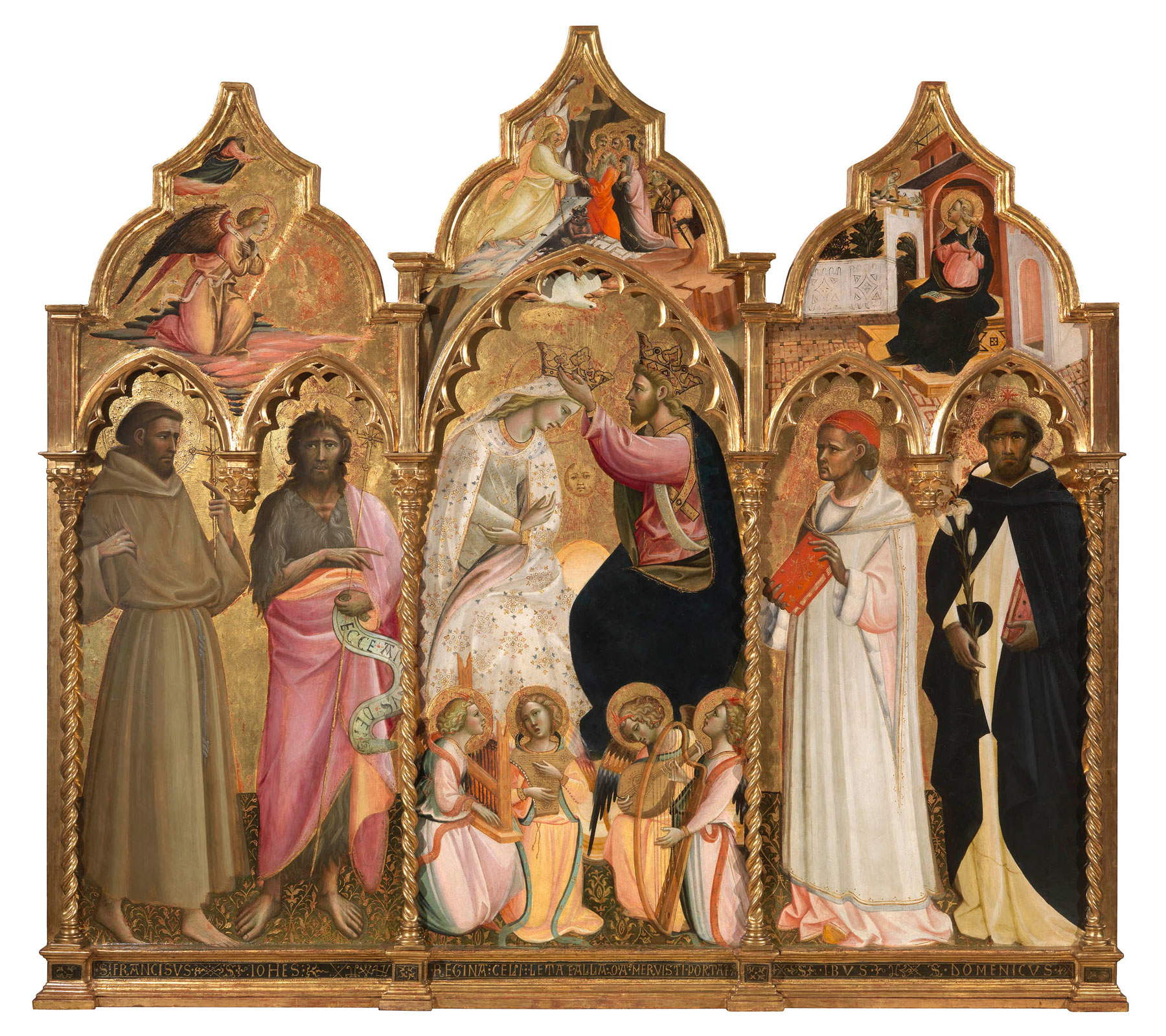


Within a few years, during the third decade, Giovanni fired two important triptychs with the same theme of theCoronation of the Virgin at their center: the one on display at the Musée Condé in Chantilly and the other in the Galleria dell’Accademia in Florence, possibly from the church of Santa Maria della Pieve in Arezzo. Kneeling at the foot of theCoronation throne are four angels (some of them also singers), distilling the sounds of a harp, a guitar, and a portative organ; the only difference is in the fourth instrument, which is a psaltery in Florence and a viella (otherwise known as a violetta) in Chantilly. Even with these differences, it is on the whole an ensemble that can be ascribed to the group of instruments bas, with weak sound intensity, intimate and rarefied. However, the Chantilly triptych is enriched by two lateral buttresses, where three more pairs of angelic creatures appear: on the left they play wind instruments (two ciaramelle and a pair of naccarini), while on the right a bagpipe, a tambourine and a triangle. It is quite likely that originally pillars of this type also closed the Florentine triptych at the sides: thus, likewise, the instruments hauts would have flanked the low ones, creating a more complete and richer musical theophany as a glorification of Mary’s Coronation. The event is celebrated somewhat differently by the Camaldolese Lorenzo Monaco and the Dominican Fra Angelico: the former selects fewer instruments in the large altarpiece for the high altar of his order’s Florentine church, Santa Maria degli Angeli, now in the Uffizi (and limits himself to a single portative organ in the other altarpiece for the Camaldolese church of San Benedetto fuori Porta Pinti, on display at the National Gallery in London); in the Louvre altarpiece (formerly in San Domenico in Fiesole), on the other hand, the latter completes the scene with several trumpets, i.e., “high chapel” instruments that emphasize the theophanic dimension of the heavenly Coronation.
In the triptych of St. Peter’s, which is divided among several museums, the main panel (Cambridge, Fitzwilliam Museum) depicts the Madonna and Child Enthroned, surrounded by eight angels, whose vivacity is emphasized at the feverish movement of their wings and pointed expressions, consistent with the’vibrant and heated elegance that (on the level of line, movement, and color palette) Giovanni dal Ponte inferred from his beginnings from Gherardo Starnina, the artist to whom we owe the decisive burst of Florentine painting in the late Gothic sense. Two of these angels, crouching on the ground, again play a portative organ and a guitar (or lute); an instrument, the latter, which reappears, alongside the psaltery, in another central polyptych compartment, the Madonna of the De Young Memorial Museum in San Francisco.
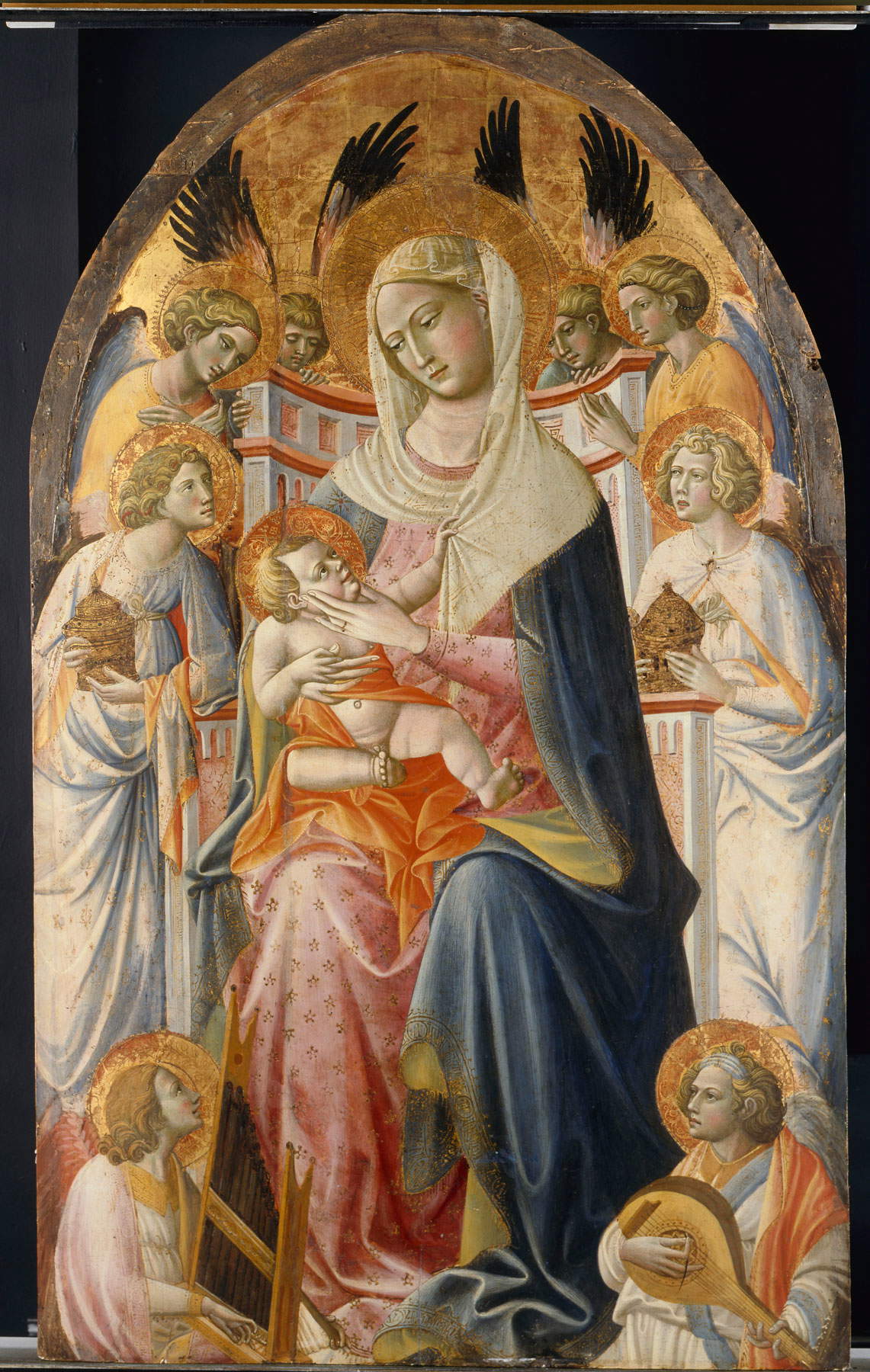
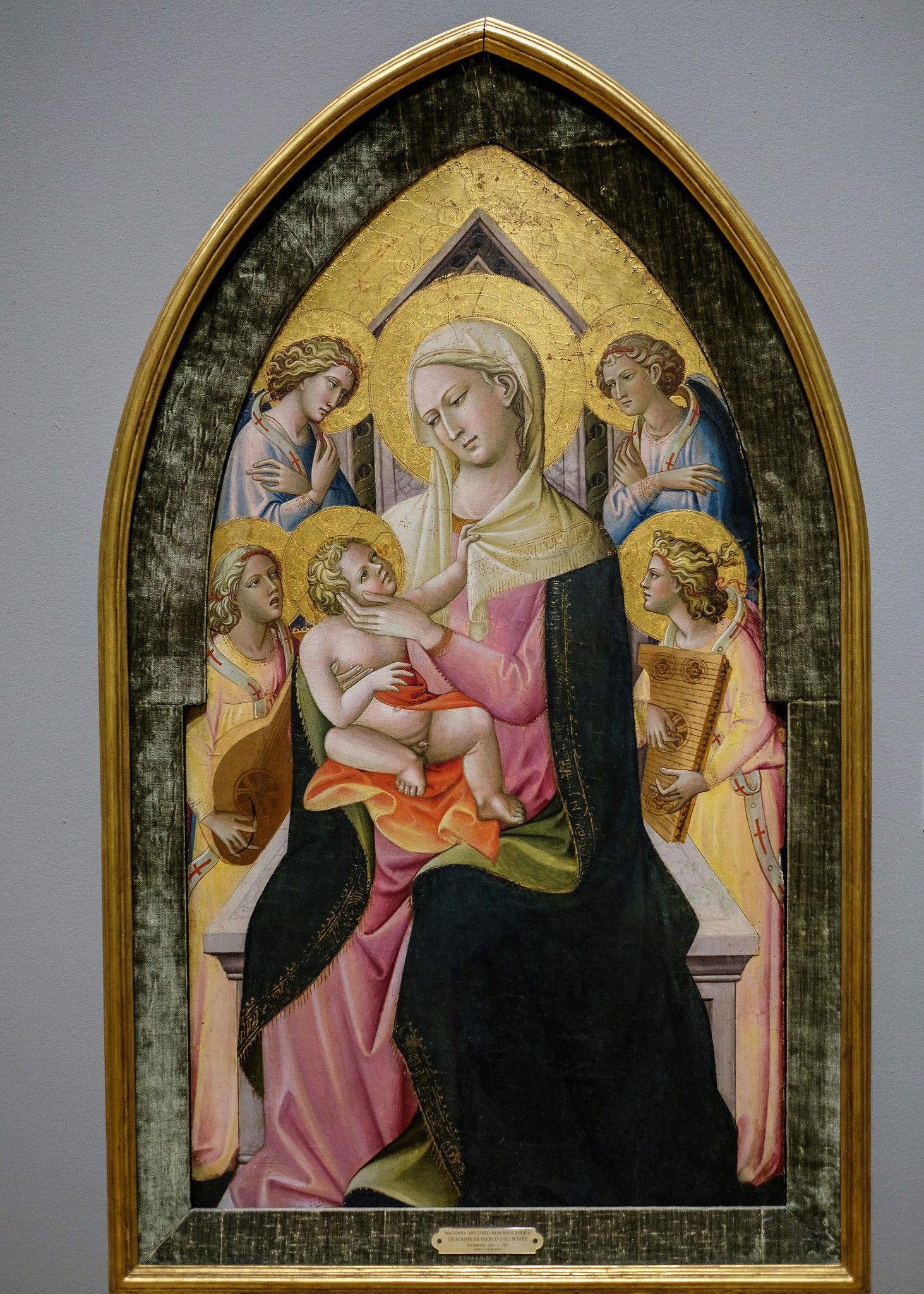
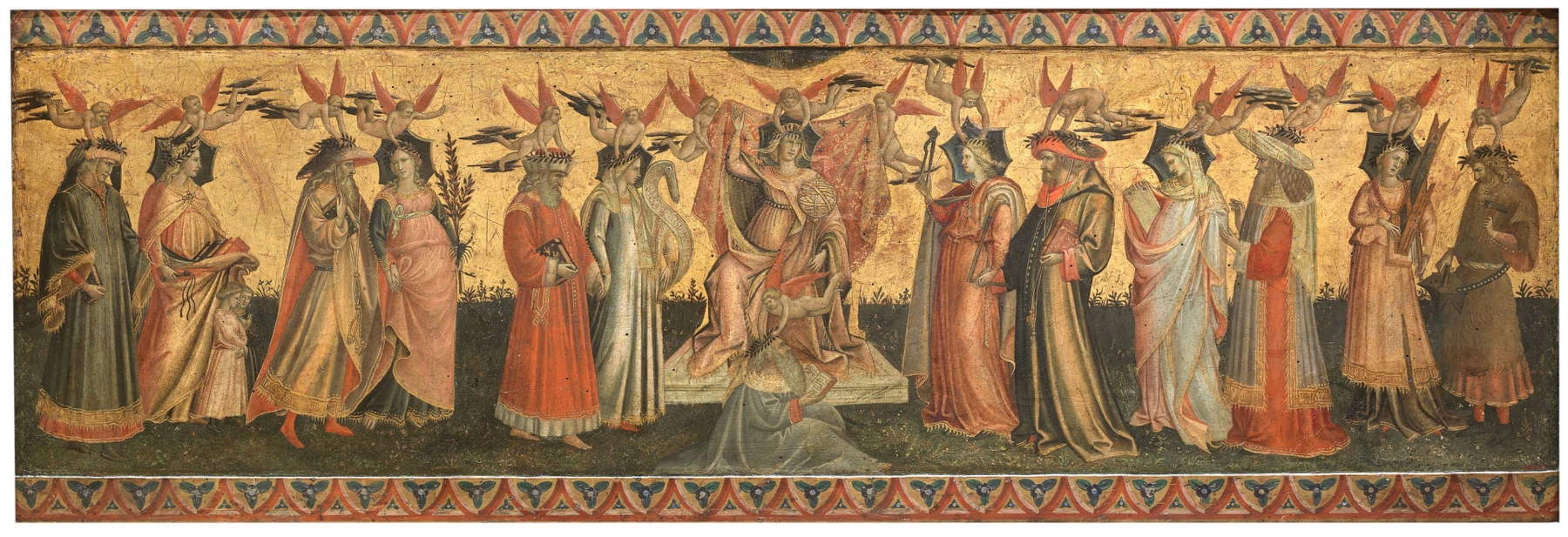
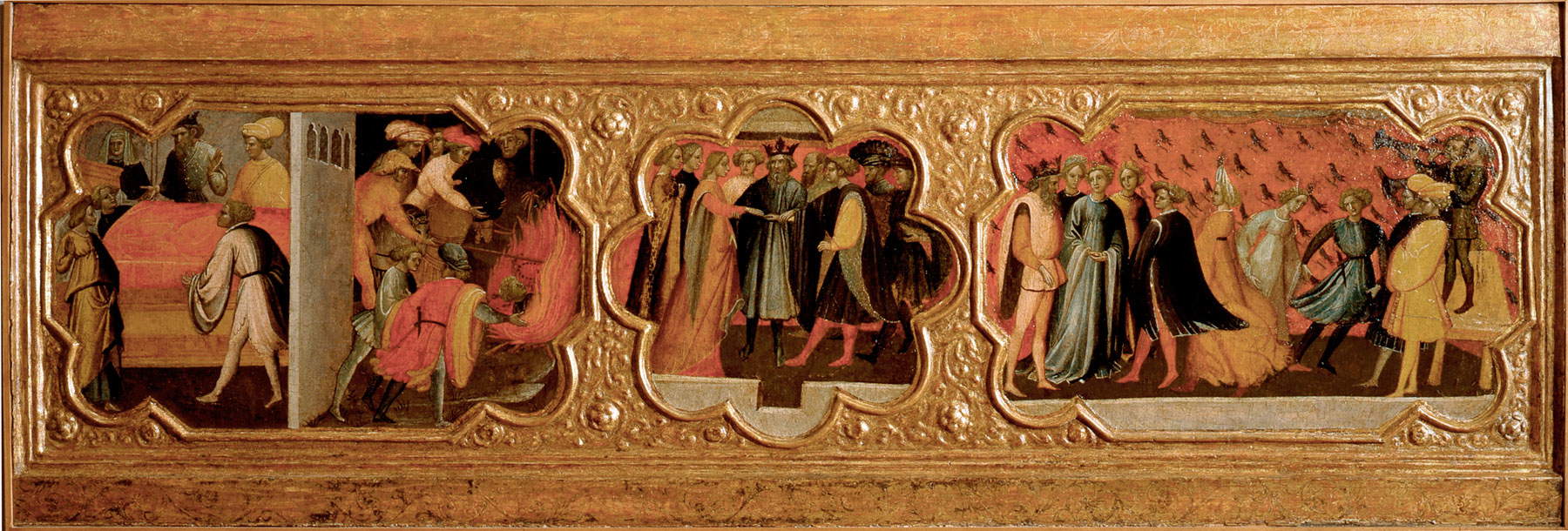

There is no shortage of examples in which musician angels flank a subject other than the Virgin Mary. At the entrance to the Scali Chapel in the church of Santa Trinita in Florence a pair of creatures with a guitar and harp glorify St. Bartholomew, to whom Giovanni dal Ponte’s fresco cycle (1434) is dedicated. But some secular depictions are also notable. This is the front panel of a chest, intended for the furnishings of a probably Florentine residence, preserved at the Museo Nacional del Prado in Madrid, in which theAllegory of the Liberal Arts is depicted, among which Astronomy stands out, towering in the center. The seven female figures are encircled on their heads by a polygonal nimbus and crowned with a laurel wreath by as many fluttering angels, as they parade through a thick and lush flowery meadow in exquisitely Gothic taste, although the work’s gestation now crosses the 1430s. Each is flanked, as in a dance, by an illustrious personage to whom she is directly related. The allegory of Music closes the group on the right, as she sings and plays a portable organ, accompanied by Tubalcain, the biblical blacksmith, maker of the oldest musical instruments, who here beats “the rhythm with two hammers on an anvil, tied to her waist like a parade drum,” as Lorenzo Sbaraglio writes. A second nuptial caisson front, with some episodes from Giovanni Boccaccio’s Teseida (La Spezia, Museo Civico “Amedeo Lia”), concludes with the wedding celebrations of Emilia and Palemone, in an interior that transfigures (complete with a vermilion tapestry quilted with birds) the atmosphere of contemporary life, amid trumpet players and dances, all festively parade. Another caisson panel, depicting the Garden of Love (New Haven, Yale University Art Gallery), is more ruined, but one can clearly recognize on the far left a young man plucking the strings of a lute and a maiden intoning the sound of a harpette, thus harmonizing the dance of a group of young people.
It is with images such as these, agreeable to the marital auspices and domestic life of the Florentine bourgeoisie, that an artist such as Giovanni dal Ponte celebrated the dream of a playful and harmonious life, amid the delights of gardens no less heavenly for earthly joys than the heavenly processions animated by the transcendental sonorities of angels. And equally punctuated by the softest and most delicate colors of Gothic at its decline.
Read more:
Giovanni dal Ponte, protagonist of Florentine Late Gothic Humanism, exhibition catalog edited by A. Tartuferi and L. Sbaraglio, Florence, Giunti, 2016 (especially the essay by A. Soldani, Musical Iconography in Giovanni dal Ponte).
Warning: the translation into English of the original Italian article was created using automatic tools. We undertake to review all articles, but we do not guarantee the total absence of inaccuracies in the translation due to the program. You can find the original by clicking on the ITA button. If you find any mistake,please contact us.